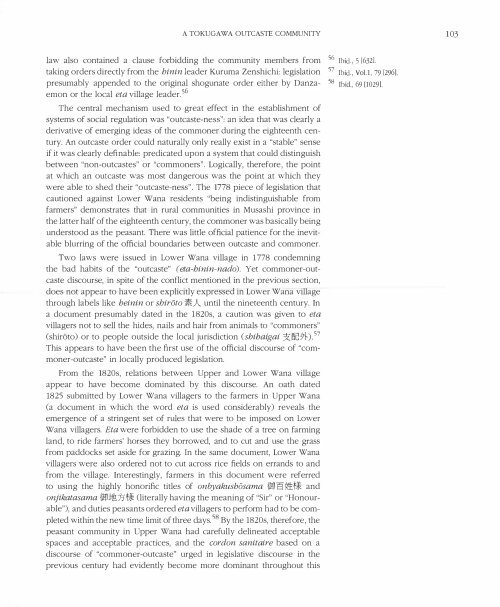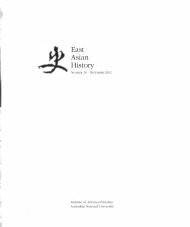Portrait of a Tokugawa Outcaste Community ... - East Asian History
Portrait of a Tokugawa Outcaste Community ... - East Asian History
Portrait of a Tokugawa Outcaste Community ... - East Asian History
Create successful ePaper yourself
Turn your PDF publications into a flip-book with our unique Google optimized e-Paper software.
A TOKUGAWA OUTCASTE COMMUNITY 103law also contained a clause forbidding the community members from56 Ibid. , 5 [632J.taking orders directly from the hinin leader Kuruma Zenshichi: legislation 57 Ibid. , YoU , 79 [296].presumably appended to the original shogunate order either by Danza- 58 Ibid., 69 [1029].emon or the local eta village leader. 56The central mechanism used to great effect in the establishment <strong>of</strong>systems <strong>of</strong> social regulation was "outcaste-ness": an idea that was clearly aderivative <strong>of</strong> emerging ideas <strong>of</strong> the commoner during the eighteenth century.An outcaste order could naturally only really exist in a "stable" senseif it was clearly definable: predicated upon a system that could distinguishbetween "non-outcastes" or "commoners". Logically, therefore, the pointat which an outcaste was most dangerous was the point at which theywere able to shed their "outcaste-ness". The 1778 piece <strong>of</strong> legislation thatcautioned against Lower Wana residents "being indistinguishable fromfarmers" demonstrates that in rural communities in Musashi province inthe latter half <strong>of</strong> the eighteenth century, the commoner was basically beingunderstood as the peasant. There was little <strong>of</strong>ficial patience for the inevitableblurring <strong>of</strong> the <strong>of</strong>ficial boundaries between outcaste and commoner.Two laws were issued in Lower Wana village in 1778 condemningthe bad habits <strong>of</strong> the "outcaste" (eta-hinin-nado). Yet commoner-outcastediscourse, in spite <strong>of</strong> the conflict mentioned in the previous section,does not appear to have been explicitly expressed in Lower Wana villagethrough labels like heinin or shiroto A until the nineteenth century. Ina document presumably dated in the 1820s, a caution was given to etavillagers not to sell the hides, nails and hair from animals to "commoners"(shiroto) or to people outside the local jurisdiction (shihaigai SZ1'lC5'}).57This appears to have been the first use <strong>of</strong> the <strong>of</strong>ficial discourse <strong>of</strong> "commoner-outcaste"in locally produced legislation.From the 1820s, relations between Upper and Lower Wana villageappear to have become dominated by this discourse. An oath dated1825 submitted by Lower Wana villagers to the farmers in Upper Wana(a document in which the word eta is used considerably) reveals theemergence <strong>of</strong> a stringent set <strong>of</strong> rules that were to be imposed on LowerWana villagers. Eta were forbidden to use the shade <strong>of</strong> a tree on farmingland, to ride farmers' horses they borrowed, and to cut and use the grassfrom paddocks set aside for grazing. In the same document, Lower Wanavillagers were also ordered not to cut across rice fields on errands to andfrom the village. Interestingly, farmers in this document were referredto using the highly honorific titles <strong>of</strong> onbyakushOsama slf* andonjikatasama t{!rnf* (literally having the meaning <strong>of</strong> "Sir" or "Honourable"),and duties peasants ordered eta villagers to perform had to be completedwithin the new time limit <strong>of</strong> three days. 58 By the 1820s, therefore, thepeasant community in Upper Wana had carefully delineated acceptablespaces and acceptable practices, and the cordon san ita ire based on adiscourse <strong>of</strong> "commoner-outcaste" urged in legislative discourse in theprevious century had evidently become more dominant throughout this
















